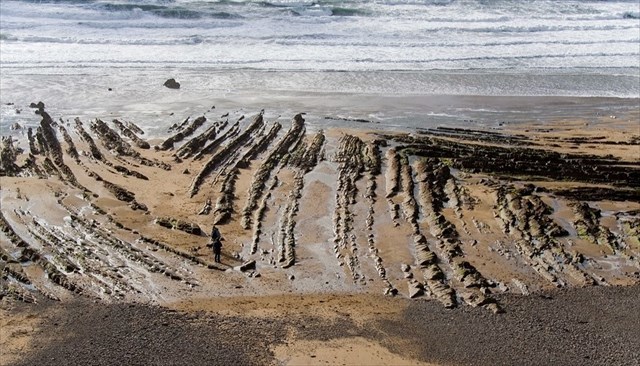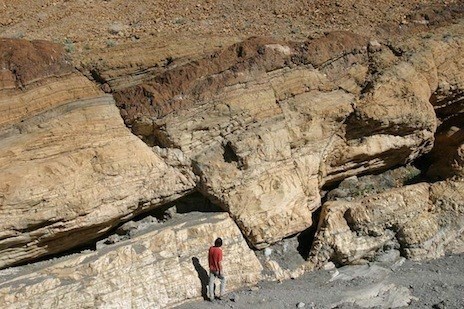
Do you remember the differences between elastic deformation and plastic deformation?
It is quite simple:
When a sufficient load is applied to a structural material, it will cause the material to change shape. This change in shape is called deformation.
A temporary shape change that is self-reversing after the force is removed, so that the object returns to its original shape, is called elastic deformation. In other words, elastic deformation is a change in shape of a material at low stress that is recoverable after the stress is removed. This type of deformation involves stretching of the bonds, but the atoms do not slip past each other.
When the stress is sufficient to permanently deform a body, it is called plastic deformation and involves the breaking of a limited number of atomic bonds by the movement of dislocations.
In rocks, the most visible effects of these two types of deformations are folds and fractures (or faults).
In igneous rocks, this effect is further accentuated because igneous rocks begin life as (viscous) liquids and end it as solid objects. In the liquid; fused, state, these can be moulded to any shape or form depending on the mould where they are intruded.

During the extrusive phase of the Volcanic Complex of Lisbon; upper Cretaceous/lower Eocene magmatic activity related to intra-continental rifting (1), the molten rocks invaded existing structures and subsequently solidified in to weird and wonderful shapes.
This EarthCache will take you to a scenic spot where you can see this for yourself. Therefore, in order to qualify for a FOUND, you just need to answer the following questions and send the answers to the owner via the profile page.
Question 1 – What shape have the basalts (the darker coloured rock) solidified into?
Question 2 – in which direction does the long arm point? Seawards or landwards?
Question 3 – How wide is the basalt closes to the cement wall?
Question 4 – These basalts sometime have green olivine crystals associated with them. Does this one have?
Question 5 – Observe the grain size of the basalt vs. the grain size of the host rock (the yellowish limestone). Which one has the finer grain size?
OPTIONAL TASK: Add to your log a scenic picture of the coastline (but not of the feature itself! – this will qualify for deletion of your log)
(1) Prudêncio, M. I., Sequeira Braga, M.A. and Cabral, J.M.P., 1990. Basalts weathering in the Lisbon volcanic complex (Portugal). Chemical Geology, V.84, Issues 1–4, P.119-121
Note: Slippery surface! Danger of falling! Do not take unnecessary chances! Watch out for the tides!

Ainda te lembras das diferenças entre deformação elástica e deformação plástica?
É bastante simples:
Quando uma carga suficiente é aplicada a um material estrutural, isso fará com que o material mude de forma. Esta mudança de forma é denominada deformação.
Uma mudança de forma temporária que é auto-reversível depois que a força é removida, de modo que o objeto retorna à sua forma original, é chamado de deformação elástica. Noutras palavras, a deformação elástica é uma mudança na forma de um material com baixa tensão que é recuperável após remoção da carga. Este tipo de deformação envolve o alongamento das ligações atómicas, mas os átomos não se deslocam.
Quando a carga é suficiente para deformar permanentemente um corpo, é chamado deformação plástica e envolve a quebra de um número limitado de ligações atómicas pelo movimento de deslocamentos.
Nas rochas, os efeitos mais visíveis desses dois tipos de deformações são dobras e fraturas (ou falhas).

Em rochas ígneas, este efeito é ainda mais acentuado porque as rochas ígneas começam a vida como líquidos (viscosos) e terminam como objetos sólidos. No estado líquido; fundido, estes podem ser moldados em qualquer forma dependendo do molde onde eles são intruídos.
Durante a fase extrusiva do Complexo Vulcânico de Lisboa; atividade magmática do Eoceno superior ao Cretáceo Inferior relacionado ao rifting intra-continental (1), as rochas derretidas invadiram as estruturas existentes e posteriormente solidificaram em formas estranhas e maravilhosas.
Esta EarthCache o levará a um local panorâmico onde podes ver isso. Portanto, para poderes registar o teu FOUND, só precisas de responder às seguintes perguntas e enviar as respostas ao proprietário através da página de perfil.
Pergunta 1 – De que forma os basaltos (a rocha colorida mais escura) se solidificaram?
Pergunta 2 - Em que direção o aponta o “braço longo”? Para o mar ou para terra?
Pergunta 3 – Qual é a larguara do basalto junto à parede de cimento?
Pergunta 4 - Esses basaltos por vezes contêm cristais de olivina (de cor verde garrafa) associados a eles. Este tem cristais de olivina?
Pergunta 5 - Observa o tamanho do grão do basalto versus o tamanho de grão da rocha hospedeira (o calcário amarelado). Qual tem a granulometria mais fina?
TAREFA OPCIONAL: Adiciona ao teu registro uma imagem do panorama litoral (mas não do basalto em si! - isso será motivo para apagar o teu registo)
(1) Prudêncio, M. I., Sequeira Braga, M.A. and Cabral, J.M.P., 1990. Basalts weathering in the Lisbon volcanic complex (Portugal). Chemical Geology, V.84, Issues 1–4, P.119-121
NOTA: Piso escorregadio! Perigo de quedas! Não arrisques! Atenção às marés!

 The most exciting way to learn about the Earth and its processes is to get into the outdoors and experience it first-hand. Visiting an Earthcache is a great outdoor activity the whole family can enjoy. An Earthcache is a special place that people can visit to learn about a unique geoscience feature or aspect of our Earth. Earthcaches include a set of educational notes and the details about where to find the location (latitude and longitude). Visitors to Earthcaches can see how our planet has been shaped by geological processes, how we manage the resources and how scientists gather evidence to learn about the Earth. To find out more click HERE.
The most exciting way to learn about the Earth and its processes is to get into the outdoors and experience it first-hand. Visiting an Earthcache is a great outdoor activity the whole family can enjoy. An Earthcache is a special place that people can visit to learn about a unique geoscience feature or aspect of our Earth. Earthcaches include a set of educational notes and the details about where to find the location (latitude and longitude). Visitors to Earthcaches can see how our planet has been shaped by geological processes, how we manage the resources and how scientists gather evidence to learn about the Earth. To find out more click HERE.